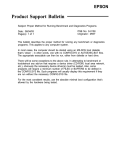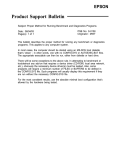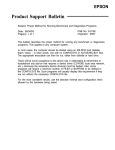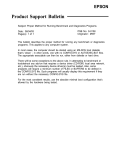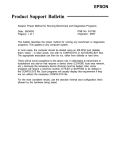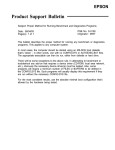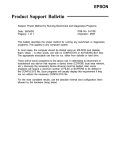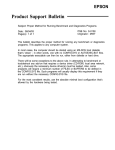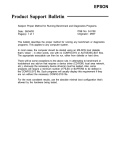Download Epson Equity III User`s guide
Transcript
EPSON Product Support Bulletin Subject: Proper Method for Running Benchmark and Diagnostics Programs Date: 06/04/93 Page(s): 1 of 1 PSB No: S-0158 Originator: MWT This bulletin describes the proper method for running any benchmark or diagnostics programs. This applies to any computer system. In most cases, the computer should be started using an MS-DOS boot diskette that’s ‘clean’ - in other words, one with no CONFIG.SYS or AUTOEXEC.BAT files. The appropriate executable can then be run, either from diskette or hard drive. There will be some exceptions to the above rule. In attempting to benchmark or troubleshoot any add-on that requires a device driver (CD-ROM, local area network, etc.), obviously the necessary device driver(s) must be loaded. Also, some programs will require a minimum number of FILES or BUFFERS to be defined in the CONFIG.SYS file. Such programs will usually display this requirement if they are run without the necessary CONFIG.SYS file. For the most consistent results, use the absolute minimal boot configuration that’s allowed by the hardware being tested. Product Support Bulletin Subject: Equity and Apex Series Compatibility with the Sysgen OmniBridge Controller and BridgeFiler External Floppy Drives Date: Page: 04/11/90 1 of 3 PSB No: Originator: S-0088B KAS 60 The purpose of this bulletin is to provide the results of compatibility testing conducted by the Computer Product Support Center with the Sysgen OmniBridge controller and Bridge - Filer external floppy disk drives. Comments Equity I The Equity I was found compatible with the OmniBridge controller. It was able to support one or two external disk drives (daisychained) together. The external drives could be used as high density (1.2M and 1.44M) or normal (360K and 720K) disk drives. Equity II The Equity II was found to be totally incompatible with the OmniBridge controller. Equity III The Equity III was found compatible with the OmniBridge controller. It was able to support one or two external disk drives (daisychained) together. The external drives could be used as high density (1.2M and 1.44M) or normal (360K and 720K) disk drives. Equity I + The Equity I + was found compatible with the OmniBridge controller. It was able to support one or two external disk drives (daisychained) together. The external drives could be used as high density (1.2M and 1.44M) or normal (360K and 720K) disk drives. Equity le The Equity le was found compatible with the OmniBridge controller. It was able to support only one external floppy drive, unlike the other models tested. The drive could be used as a high density (1.2Mb and 1.44Mb) or normal (360K and 720K) disk drive. PSB No: S-0088B Page: 2 of 3 Equity II + The Equity II + was found compatible with the OmniBridge controller. It was able to support one or two external disk drives (daisychained) together. The external drives could be used as high density (1.2M and 1.44M) or normal (360K and 720K) disk drives. Equity lIe The Equity Ile was found compatible with the OmniBridge controller. It was able to support one or two external disk drives (daisychained) together. The external drives could be used as high density (1.2M and 1.44M) or normal (360K and 720K) disk drives. Equity Ill + The Equity III + was found compatible with the OmniBridge controller. It was able to support one or two external disk drives (daisychained) together. The external drives could be used as high density (1.2M and 144M) or normal (360K and 720K) disk drives. Equity 386SX The Equity 386SX was found compatible with the OmniBridge controller. It was able to support one or two external disk drives (daisychained) together. The external drives could be used as high density (1.2M and 144M) or normal (360K and 720K) disk drives. Equity 386/20 The Equity 386/20 was found compatible with the OmniBridge controller. It was able to support one or two external disk drives (daisychained) together. The external drives could be used as high density (1.2M and 1.44M) or normal (360K and 720K) disk drives. APEX The Epson APEX was found compatible with the OmniBridge controller. It was able to support one or two external disk drives (daisychained) together. The external drives could be used as high density (1.2M and 1.44M) or normal (360K and 720K) disk drives. APEX + The Epson APEX was found compatible with the OmniBridge controller. It was able to support one or two external disk drives (daisychained) together. The external drives could be used as high density (1.2M and 1.44M) or normal (360K and 720K) disk drives. PSB No: S-008B Page: 3 of 3 APEX 100 The Epson APEX 100 was found compatible with the OmniBridge controller. It was able to support one or two external disk drives (daisychained) together. The external drives could be used as high density (1.2M and 1.44M) or normal (360K and 720K) disk drives. APEX 200 The Epson APEX 200 was found compatible with the OmniBridge controller. It was able to support one or two external disk drives (daisychained) together. The external drives could be used as high density (1.2M and 1.44M) or normal (360K and 720K) disk drives. NOTE: The recommended switch settings for the OmniBridge controller are as follows: 1-1 1-2 1-3 1-4 DOWN DOWN DOWN DOWN 2-1 2-2 2-3 2-4 DOWN DOWN UP UP These settings select NO ADDRESS for the OmniBridge BIOS and allow it to coexist with the internal FDC of the computer in which it is being installed. This way you do not need to disable the internal FDC or connect any cables from the OmniBridge to internal floppy drives. This was found to be a universal setting for all of the computers listed above as compatible with the OmniBridge controller. Product Support Bulletin Subject: Apex / Apex Plus / Equity Series Keyboards PSB No: S-0080 Originator: REMAL Date: 4/19/89 Page: 1 of 1 The purpose of this bulletin is to provide information on the various keyboards used with the Apex, Apex Plus and Equity series computers and the part numbers of the keyboard subassemblies used with these keyboards. The Apex and Apex Plus computer keyboards are to be replaced as whole units. The The Equity series keyboards are repaired to the subassembly level. Equity III keyboard PCB assembly is the only one that comes with the key top set attached. Since some of the keyboards have the same model numbers, the difference can be determined by the FCC ID number in those cases. The chart below provides a quick reference to determine the part number of the main keyboard PCB assembly, key top set, control logic subassembly, and keyboard cable. Apex / Apex Plus Keyboard Unit Model Apex Apex Plus Equity I, II, Ill Model A265091A 93553905410 Equity I/II Equity Ill Keyboard PCB Assy Y145501001 KAFLZ3AEPS1 Keyboard Cable Key Top set Y145501021 attached Y144305000 KACCL060UCA Equity I +, II +, Ill+, 386/20 Model Code FCC ID Keyboard PCB Assy Control Board attached attached none Y171501017 Key Top set Keyboard Cable Y127501022 Y127501022 Y127501022 Y127501022 Y127501031 Y127501031 Y163502020 Y163504006 Equity le Model E1160A Code FCC ID Keyboard PCB Assy - C9S4D84701-201 Y163504007 Control Board Y171501017 Key Top set Y171501007 Keyboard Cable Y171501006 Product Support Bulletin Subject: Equity Series HDD Controllers Jumper Settings Date: Page: 6/12/89 1 of 8 PSB NO.: S-0070A Originator: APA ap’ This bulletin provides information on the jumper settings for the hard disk controllers used in Epson Equity computers. Please refer to the following pages for information regarding specific hard disk controllers: Model # Page # WD1002A - WX1 . . . . . . . . . . 2 WD1002S - WX2 . . . . . . . . . . 3 WD1003 - WAH . . . . . . . . . 4 WD1002 - WAH . . . . . . . . . 5 . . . . . . . . . . . . . . . . 6 WHDC WD1006S - WAH . . . . . . 7 ACB - 2320 . . . . . . . . . . . . . 8 HDD Controller WD1002A-WX1 (8-bit) Model number -------- -- Extra jumper FACTORY SETTINGS Position Description W1 N/A Not used. W2 N/A Not used. W3 1 to 2 BIOS ROM is enabled (on controller). W4 2 to 3 Device address 320H. W5 * hard-wired 1 to 2 BIOS ROM size (32K or 64K). W6 2 to 3 Reduced write current (< = 8 heads). W7 * hard-wired 1 to 2 IRQ 5. W8 2 to 3 Disk controller I. D. (set to be the first). Jumper * No jumper pins - 1 and 2 are connected by a PCB board etch. HDD Controller WD1002S-WX2 (8-bit) Jl ‘--Extra jumper I FACTORY SETTINGS Jumper 0 I Model number--j Position Description W1 1 to 2 Required for this configuration. W-2 1 to 2 Required for this configuration. W3 1 to 2 BIOS ROM is enabled (on controller). W4 2 to 3 Device address 320H. W5 * hard-wired 1 to 2 BIOS ROM size (32K or 64K). W6 2 to 3 Reduced write current (< = 8 heads). W7 * hard-wired 1 to 2 IRQ 5. * No jumper pins - 1 and 2 are connected by a PCB board etch. HDD Controller WD1003-WAH (16-bit) Model number FACTORY SETTINGS Jumper W1 W2 W3 W4 W5 W6 Position 1 to 2 No jumper * No jumper 2 to 3 2 to 3 2 to 3 * No jumper pins. Connection of LED indicator cable : Description Model Pin 1 of J6 Status read is latched. Primary address selected. Required for this configuration. Required for this configuration. Standard configuration. Standard configuration. Equity III Equity II + Equity III + Orange wire Blue wire Red wire HDD Controller WD1002-WAH (16-bit) FACTORY SETTINGS Model number -~ j Jumper Position Description W1 1 to 2 Primary base address. W2 Center to NL HDD activity LED only lights when the controller accesses the drive. Connection of LED indicator cable : Model Pin 1 of J4 Equity III Equity II + Equity III + Orange wire Blue wire Red wire HDD Controller WHDC (16-bit) CN6 n l : -4 0 FACTORY SETTINGS Connection of LED indicator cable : Jumper Position Description Model Pin 1 of CN6 * JP1 (J1) * JP2 (J2) * JP3 (J3) JP4 to JP8 *2 to 3 (B to C) * 1 to 2 (A to B) * 1 to 2 (A to B) No jumper pins. Primary address selected. Status read is non-latched (select = drive busy). WAH mode (dual HDD controller). Hardwired to factory settings. Equity III Equity I I + Equity I I I + Orange wire Blue wire Red wire * “JP” may labeled as “J”, “1” as “A”, “2” as “B” and “3” as “C”. HDD Controller WD1006S-WAH (16-bit) Model number FACTORY SETTINGS Connection of LED indicator cable : Jumper Position Description Model Pin 1 of J1 W1 W2 W3 W4 W5 W6 * 1 to 2 1 to 2 No jumper * No jumper * 1 to 2 * No jumper LED lights for drive selection (non- latched). No reduced write current, Enables cacheing. Isolates mounting bracket from logic ground. Primary controller port. Non-latched mode. Equity 386/20 Red wire * No jumper pins. HDD Controller ACB-2320 (16-bit) FACTORY SETTINGS Jumper J5 J6 J7 J8 J9, J10, J11 J12 J13 Position No jumpers No jumpers No jumper No jumpers No jumpers 1 to 2 No jumper Description Connection of LED indicator cable : Model Used for hardware port addressing. Equity 386/20 Manufacturing test points (DO NOT JUMPER). Serial monitor output (DO NOT JUMPER). Manufacturing test points (DO NOT JUMPER). Not used. Selects IRQ 14. ACB-BIOS disabled (no ROM present in location U25). Pin 1 of J4 Red wire EPSON AMERICA, INC. PRODUCT SUPPORT BULLETIN SERVICE PSB NO. : S-0068 DATE: 1/25/89 ORIGINATOR: RE PAGE: 1 of 6 II AND III MAIN BOARD JUMPER CONFIGURATIONS SUBJECT: EQUITY I, This bulletin describes the jumper locations and settings on the Equity I MRS board and Equity II MCY board used for configuring the computers for third party keyboards and for It also describes the enabling an 8087 math coprocessor. various releases of the Equity II MCY boards and the features that each version supported. The Equity III main board dip switch settings, to set up or change system configuration, are also provided. Index Equity I MRS Board jumpers........................Page 2 Equity II MCY Board P/N Y1442071000 Rev. OO.......Page 3 Equity II MCY Board P/N Y1442071000 Rev. O1.......Page 4 Equity II MCY Board P/N Y1442071000 Rev. O2.......Page 4 Equity II MCY Board P/N Y1442075000 . . . . . . . . . . . . ..Page 5 Equity II MCY Board P/N Y1442076000 . . . . . . . . . . . . ..Page 5 Equity EPSON III Main AMERICA Board SERVICE, Dip-switch 23610 TEL0 configuration....Page AVENUE, TORRANCE, CALIF. 6 90505 u EQUITY I MARS BOARD CONFIGURATIONS JUMPER I I I I CN2 CN1 1 8250 1 i CN3 8087 socket 3D 1 MRS-MT BOARD 8OC88 CPU MARS BOARD 4D CN12 CN11 FDD(B) (A) ml [ROM B I O S ] CN10 CN9 PLEASE NOTE Since setting the jumpers requires almost complete disassembly of the Equity I computer it should be done only by authorized Epson Customer Care Centers. 1 opt. 256KB RAM Board CN5 82C59 I 1 A =p] Reset Dip Switch Keyboard * NON-EPSON KEYBOARD SUPPORT - Install jumpers in positions J2 and position J3 (Early systems did not have this capability and do not have these jumper positions installed.) NOTE: DO NOT ATTEMPT TO USE THE EPSON KEYBOARD WITH THESE JUMPERS INSTALLED AS DAMAGE WILL RESULT! * 8087 SUPPORT - Remove the jumper from position J1. * EGA MONITOR SUPPORT - Set dip switches 6 and 7 to the on position. ----- Page 2 of 6 ----- EQUITY II MCY BOARD Y147201000 REV. 00 JUMPER CONFIGURATIONS Reset Dip Switch Vol. Keyboard JUMPER CONFIGURATIONS * There are no jumpers on this version board. The board is hard-wired to provide RAM refresh to the option slots. * An 8087 coprocessor cannot be used. * There is no provision for using alternate keyboards. ----- Page 3 of 6 ----- EQUITY II MCY BOARD Y147201000 REV. 01 & 02 JUMPER CONFIGURATIONS MCY board Y147201000 revision 01 and 02 differences. Revision 02 MCY boards have the following improvements over the 01 revision MCY board. * Serial port works over 1200 baud. * Concurrent operation of 8087 & optional Dynamic RAM or EGA/VGA. * Topview fix incorporated on MCY (main) board. Reset JUMPER Dip Switch Vol. Keyboard CONFIGURATIONS * J1 and J2 should be in position 2 to enable DMA RAM refresh to the option slots for expanded memory boards or EGA/VGA video boards. An 8087 will function concurrently with dynamic RAM boards on Rev. 02 boards with the jumpers in position 2. * J1 and J2 should be in position 1 to disable DMA RAM refresh. The V30 runs about 20% faster in this position. 8087-2 enabled on Rev. 01 MCY board. * J3 and J4 are not available on these versions of MCY board. Non-Epson keyboards cannot be used. ----- Page 4 of 6 ----- EQUITY II MCY BOARD Y147205000 & Y147206000 JUMPER CONFIGURATIONS MCY board Y147205000 and Y1472056000 differences. MCY P/N Y147206000 boards have the following improvements over the Y147205000 board. * Serial port works over 1200 baud. * Concurrent operation of 8087 & optional Dynamic RAM or EGA/VGA. * Topview fix incorporated on MCY (main) board. On Batt Off Reset I JUMPER Dip Switch Vol. Keyboard CONFIGURATIONS * J1 and J2 should be in position 2 to enable DMA RAM refresh to the option slots for expanded memory boards or EGA/VGA video boards. The 8087 will work in DMA refresh mode with the Y147206000 board. * J1 and J2 should be in position 1 to disable DMA RAM refresh. The V30 runs about 20% faster in this position. The jumpers must be in position 1 to enable an 8087 with the Y147205000 MCY board * J3 and J4 should be in position 1 to use an IBM compatible keyboard. * J3 and J4 should be in position 2 (default) for the Equity II keyboard. NOTE: DO NOT ATTEMPT TO USE THE EPSON KEYBOARD WITH JUMPERS J3 AND J4 IN POSITION 1 AS DAMAGE MAY RESULT! ----- Page 5 of 6 ----- EQUITY Ill MAIN BOARD DIP-SWITCH SETTINGS DIP Switch SWITCH FUNCTIONS Function (*Factory On settings) Off 1-1 RAM size Monitor type PROM size Disable 640KB* Monochrome* Color See Table 4-2 in User's Guide 2-1 Serial Port Unused Floppy Disk FDC Parallel Port Enable* 1-2 1-3 - 1-6 ;I; 2-4 Enable* Enable* Disable Disable* Disable Disable ----- Page 6 of 6 ----- EPSON EPSON AMERICA, INC. PRODUCT SUPPORT BULLETIN SERVICE PSB NO.: S-0065 DATE: 1/5/89 ORIGINATOR: AGE: 1 of 1 REM/ SUBJECT: DISABLING THE FLOPPY DISK CONTROLLER IN EPSON COMPUTERS This bulletin covers the ability or inability to floppy disk controller in the Epson computers. COMPUTER Equity I II Equity III I+ Equity II+ 1OMHz 12MHz Equity the HOW No Equity Equity FDC CAN BE DISABLED disable III+ No Yes CPU Board - Switch 2-3 off Yes CPU Brd - Jumper 1 in Position B Multi-function No Yes Board - Jumper 2 in Position B Yes Multi-function Board - Jumper 1 in Position B - Jumper 2 in Position B Apex Apex Plus EPSON AMERICA Yes Motherboard - Remove Jumper El No SERVICE, 23610 TEL0 AVENUE, TORRANCE, CALIF. 90505 PSB No.: S-0062I Page: 1 of 18 EQUITY III VER L1.07 H1.07 L1.09 H1.09 L1.10 H1.10 PART # KQQNK1019A KQQNK1020A KDPN0000100 KDPN0000110 DESC 27128D-2 27128D-2 27128D-2 27128D-2 27128D-2 27128D-2 TYPE M27C128 M27C128 M27C128 M27C128 M27C128 M27C128 LOC U147 U146 U147 U146 U147 U146 REASON INITIAL RELEASE To allow the use of drives with more than 8 heads. Requires U99 chip upgrade to DEC01A. Fixes problems with drive type table, 3270 emulation, Novell 286 v2.0a and Thesys Fastcard III. Product Support Bulletin Subject: Using Expanded Memory with Equity and Apex Computers Date: Page: 3/2/90 1 of 6 Q1. A. Q2. A. PSB No: Originator: S-0047C KAS ‘/“p& What is Expanded Memory? Conventional memory, managed by MS - DOS, is limited to 640K. In response to the need for greater amounts of accessible memory, the LIM EMS (Lotus/Intel/Microsoft Expanded Memory Specification) was introduced in 1984. EMS, version 3.2, provides usable memory beyond the 640K limit through “bank switching”. The expanded memory is divided into 16K portions called “pages”. The computer accesses these pages through a “page frame” or “window” which is 64K of memory located between 768K and 896K in 80286 - based systems and between 800K and 960K in 8086 - or 8088 - based systems. 16K pages of memory are allocated for an application’s use and the EMM (Expanded Memory Manager) handles the job of mapping the pages in and out of the page frame as they are needed. However, in order to make use of expanded memory, the software must be written to take advantage of the EMS. Software such as Lotus 1 - 2 - 3, Microsoft Windows and Borland’s SideKick Plus make use of expanded memory. EMS is limited to 8Mb of expanded memory. What is EEMS? A superset of EMS, AQA EEMS (AST/Quadram/Ashton - Tate Enhanced Expanded Memory Specification) provides greater flexibility in the mapping of expanded memory. However, it also uses the technique of “bank switching” and has its own memory manager which accommodates such specially written software as Quarterdeck’s DESQview. EEMS is also limited to 8Mb of expanded memory. PSB No: S-0047C Page: 2 of 6 Q3. A. Q4. A. Q5. A. What about the 155Mb RAM listed as the maximum for the Equity III +? This larger amount of RAM is the maximum usable memory range for an 80286 microprocessor and generally refers to extended memory. Extended memory starts at the 1Mb boundary and extends out to 16Mb. As it requires a 24 - bit address to access memory in this range, extended memory is handled by the protected mode of the 80286. Examples of currently available software that can switch into protected mode to use extended memory are Framework II, AutoCAD, the VDisk RAM disk and Xenix OS. How does LIM EMS 4.0, the latest version, differ from the earlier version, LIM EMS 3.2? EMS 4.0 supports up to 32Mb of expanded memory where EMS 3.2 supported only 8Mb. EMS 4.0 has been changed to make it easier for applications to share expanded memory. In EMS 4.0, page mapping has been streamlined and new functions allow application programs to dynamically increase and decrease the amount of expanded memory allocated to them. In previous versions of EMS, the page frame was located in an unused 64K block of memory between 640K and 1Mb. EMS 4.0, subject to limitations in the system hardware, supports the page frame anywhere in the first 1Mb of memory. Before EMS 4.0, the page frame held four pages. Now you can define a page frame of up to eight pages in memory above 640K. The size of the page frame is limited only by the amount of available memory. There has also been a change to support the smaller than standard (16K) memory pages used by some expanded memory boards. Is EMS 4.0 compatible with my old expanded memory board? The EMM 4.0 driver works with existing hardware. You don’t need to buy a new expanded memory board. However, until you use applications that have been written to take advantage of EMS 4.0, you probably won’t notice much improvement in performance over your older version. PSB No: S-0047C Page: 3 of 6 Q6. What memory expansion boards are compatible with the Equity I and Equity II? A. The following boards have been tested by Epson in the Equity I and II: All Card w/MMU Multifunction Liberty PC Mini Magiccard (EV - 138) AST SixPak Premium AST Rampage All Computers, Inc. Quadram Corporation Everex Systems, Inc. AST Research AST Research Q7. What memory expansion boards are compatible with the Equity Ill? A. The following boards have been tested by Epson in the Equity Ill: Grande Byte Intel Above Board AT Liberty AT AST Advantage AST Rampage AT AST Ramvantage STB Systems Intel Corporation Quadram Corporation AST Research AST Research AST Research Q8. What memory expansion boards are compatible with the Equity I +? A. The following boards have been tested by Epson in the Equity I +: 64/256KB Expansion Option Above Board PC (1985) Fastcard IV (1.6) IBM Intel Corporation Thesys Q9. What memory expansion boards are compatible with the Equity le? A. The following boards have been tested by Epson in the Equity le: 64/256KB Expansion Option Quad Board II Fastcard IV RAMpage IBM Quadram Thesys AST Research Note: The Intel Above Boards do not currently operate reliably with the Equity le. PSB No: S-0047C Page: 4 of 6 Q10. What memory expansion boards are compatible with the Equity II + and Equity Ill + (10MHz models)? A. The following boards have been tested by Epson in the Equity II + and Equity Ill + (10MHz models): Advantage Premium Rampage 286 * Above Board 286 Above Board 286 p/s * Grande Byte * Rio Grande Elite 16 AST Research AST Research Intel Corporation Intel Corporation STB Systems STB Systems Profit Systems * Will run at 8MHz, not at 10MHt. Q11. What memory expansion boards are compatible with the Equity II + and Equity Ill + (12MHz models)? A. The following boards have been tested by Epson in the Equity II + and Equity III + (12MHz models): Rampage 286 Plus Elite 16 Above Board Plus AST Research Profit Systems Intel Corporation NOTE: Previously boards from Micron Technology were listed as compatible with the 12MHz models of the Equity II + and Equity Ill +. They have been removed from the list because Micron no longer produces ISA memory boards. Q12. A. How do you expand the memory of the Equity 386/20? Memory expansion in the Equity 386/20 can be accomplished by adding SlMMs (single in - line memory modules) to the CHET - RM board. Both 256K and 1Mb SlMMs are available from Epson America. The 256K SlMMs are sold in 1Mb kits and the 1Mb SlMMs are sold in 2Mb kits. Compatible third party 1Mb SlMMs are available from Matsushita, Toshiba and CDC Enterprises. You can also use third party memory expansion boards such as those listed above for the Equity II +/Ill +. PSB No: S-0047C 5 of 6 Page: Q13. A. Are there any guidelines to installing the SlMMs in the Equity 386/20? Yes, when SlMMs are installed to increase memory beyond 1Mb, they must be installed so that banks of SlMMs are installed as matched pairs. See the matrix below: Memory Bank 0 1MB 2MB 4MB 4MB 8MB 10MB 16MB 4X256KB 4X256KB 4X256KB 4X1MB 4X1 MB 4X1 MB 4X1 MB Note: Bank 1 Bank 2 Bank 3 4X256KB 4X256KB 4X256KB 4X256KB 4X1 MB 4X1 MB 4X1 MB 4X256KB 4X256KB 4X1 MB 4X1 MB Refer to PSB S - 0095 for 18MB RAM Setup information. Q14. Is there a driver supplied with the Equity 386/20 to allow the use of the extended memory as expanded memory? A. Yes, the Equity 386/20 system software includes the device driver EEMM386EXE. This driver emulates LIM EMS 4.0 memory using the extended memory supplied by the additional SIMMs. It will support only the onboard memory above 1 MB, up to 15MB. This is the maximum memory that can be installed on the CHET- RM board. It will not support memory installed on memory expansion boards. Q15. Are there any expanded memory boards that are compatible with the Equity LT? A. No, the option slots on the LT require a special connector. The hard drive controller and the LT cartridge modem are the only option cards currently available from Epson America. Q16. What expanded memory boards are compatible with the Apex by Epson? A. The Above Board PC from Intel Corporation has been tested by Epson in the Apex. PSB No: S-0047C Page: 6 of 6 Q17. Are there any general guidelines for determining the chip speed to install on the memory expansion boards? A. Yes, if the CPU speed is 8MHz or less, use 150ns RAM chips. If the CPU speed is 10/12MHz, use 120ns RAM chips. Q18. Is there anything that should be kept in mind during the installation procedure for the memory expansion boards? A. Yes, when installing the memory boards in the Equity II + and Equity Ill + (12MHz models), remember that the bus speed is 12MHz. For example, the Intel Above Board 288 and Above Board Plus allow you to set up the bus speed and chip speed in their installation programs. Q19. What is meant by backfilling memory when using software such as DESQview? A. Backfilling is a function of many expanded memory boards which allows a portion of the board’s memory to be used as conventional memory. In this way, you could turn a 256K system into one with 840K memory or more. In certain situations, you may want to disable some of the computer’s conventional memory and the use the memory on the expansion board (i.e. DESQview). Q20. Which Epson computers have memory settings that allow backfilling memory? A. The Equity I, Equity I +, Equity II + and Equity Ill + allow backfill. The Equity I comes with 256K standard and the Apex comes with 512K, thus allowing backfill. The Equity I + has DIP switch settings allowing system memory to be disabled to 256K or 512K. The Equity II+ and Equity Ill + have jumpers on the system memory boards to allow memory to be disabled to 256K and 512K. EPSON EPSON AMERICA INC. SERVICE DEPARTMENT PRODUCT SUPPORT BULLETIN DATE: 3/28/88 SUBJECT: EPSON EQUITY I/II/III ENHANCED KEYBOARD NUMBER: S-0041 COMPATIBILITY to provide information The purpose of this bulletin is third party enhanced "AT" style the compatibility of with the Equity I, Equity II and Equity III computers. 1. Keyboard regarding keyboards Compatibility The enhanced Equity "Plus" series keyboard cannot be used on an III. The enhanced Equity keyboard (as with Equity I, II or which is not requires explicit ROM BIOS IBM's) support available in the earlier machines. however, to use a third-party "enhanced-style" It is possible, IBM XT-101, NorthGate C/T-101, Datadesk keyboard such as the 5151. Please note that Turbo-101, Keytronics 101, 5150 and early versions of the Equity I (serial numbers unavailable) and (below serial number 29875) were not designed to Equity II support any third party keyboards (they do not have any keyboard-select jumpers on the main board). The correct jumper Equity I: Equity II: settings for non-Epson keyboards J2 and J3 jumpered J3, J4 and J5 set for position PLEASE are: 1 NOTE Once the above jumper changes have been made, attempting to use the original Epson keyboard will result in damage to the keyboard and Equity main board. Page 1 of 1 EPSON EPSON AMERICA INC. SERVICE DEPARTMENT PRODUCT SUPPORT BULLETIN DATE: SUBJECT: 3/2/88 LEAP YEAR / MS-DOS 3.1 DATE CHANGE This bulletin describes a problem identified in version 3.1 which was supplied with the Equity III personal computers. NUMBER: S-0037 Epson's MS-DOS II and Equity On March 1, 1988 we discovered that the system date did not change correctly to 3-1-1988, but indicated 2-29-1988. As you may have guessed, MS-DOS 3.1 did not handle the February 29th "leap day" change correctly. Both the Equity II and Equity III use a Real Time Clock/Calendar with CMOS RAM to retain the date and time after it is set with the SETUP utility program. Even though the RTC has the correct date (03-Ol-1988), DOS interprets it as 02-29-1988. The easiest method of correcting this anomaly is to set the date in the RTC's CMOS RAM one day ahead as follows: 1. 2. 3. 4. 5. Run the Select Set the EXIT to Re-boot "SETUP" utility program. REAL-TIME CLOCK. DATE to the current date + one. save the new date. the system! When MS-DOS 3.1 retrieves the date from the RTC it subtracts the extra day and will display the correct date for system operation. This problem does not exist customer decide to upgrade. with MS-DOS Page 1 of 1 version 3.2 should the EPSON EPSON AMERICA, INC. PRODUCT SUPPORT BULLETIN SERVICE B NO.: S-0028A UBJECT: EPSON DATE: 3.5" 720KB PAGE: 1 of 1 6/29/88 FLOPPY DISK DRIVE COMPATIBILITY The purpose of this bulletin is to provide information regarding the compatibility of the Epson 3.5", 720KB floppy disk drive (Product Code A112A-AA) with the Apex and Equity series computers. The 3.5" floppy disk drive must be used with MS-DOS 3.2 or higher. Please refer information. to Apex No Equity 1 the I special Not Equity II Equity III 1 table setup for compatibility required supported Must Not following include DRIVPARM = /D:1 /F:2 in CONFIG.SYSI supported* Equity I+ No special setup required Equity II+ No special setup required I Equity III+ 1 special setup required I No The Epson 3.5" floppy disk drive is not compatible with the Equity I or the Equity III. * Manzana Microsystems Inc. offers a 3.5", 720KB floppy disk drive which is compatible with the Equity III computer when used with their 3FIVE device driver. Refer to Product Support Bulletin # S-0027A for detailed information on using the DRIVPARM command to configure Equity II systems for using the 3.5" floppy disk drive. EPSON AMERICA SERVICE, 23610 TEL0 AVENUE, TORRANCE, CALIF. 90505 E P S O N EPSON AMERICA INC. SERVICE DEPARTMENT SUPPORT PRODUCT DATE: 12/2/87 SUBJECT: EQUITY SERIES/APEX MATH BULLETIN NUMBER: S-0019B CO-PROCESSOR SELECTION GUIDE The purpose of this bulletin is to assist in selecting the appropriate numeric co-processor for use in the Epson,Equity series computers and the Epson Apex computer. Use the following table to determine Co-Processor is recommended for the EPSON COMPUTER CPU SPEED which type of Numeric corresponding computer. NUMERIC CO-PROCESSOR 80287-6 * NXP SPEED 6 MHz Product enhanced with increased CPU speed of 6/8/12Mhz starting with all units manufactured in the U.S.A.. Page 1 of 1 E P S O N EPSON AMERICA INC. SERVICE DEPARTMENT BULLETIN SUPPORT PRODUCT NUMBER: S-0018 DATE: 09/16/87 SUBJECT: Equity Series Compatibility Certifications Three more third-party vendors have published compatibility certifications for Epson Equity series PCs. Santa Cruz Operations, Fox Research Inc. and Manzana Microsystems Inc. now have certified their software and/or hardware products as specified below. Santa Cruz Operations SCO has tested and certified the latest versions of their implementation of Xenix System V. I I Xenix System V 286AT Version 2.2.1 I Xenix System V 86XT Version 2.2.1 Equity III E q u i t y I II I + --IEquity 1+ 1 When used with products such as the Arnet Multiport serial boards, this allows you to set up a multi-user, multi-tasking system. Many businesses have begun looking at PC-based Xenix as an alternative to a much more costly minicomputer installation. Fox Research, Inc. Fox Research offers a full range of hardware and software products for local area networking (LAN) solutions. I PRODUCT NAME I 10-Net Local Area Network 10-Net SNA/BSC Turbo LAN Mainframe Gateway 10-Base PRODUCT DESCRIPTION I I COMMENTS I Ethernet Standard or StarLan Standard Tested on: I Equity I+, III+ ’ I IBM 30xx, 43xx or 370 Communications Equity It, III+ I Relational Database Manager, Release 3.0 I Tested on: Equity I+, III+ Page 1 of 3 Fox Research. Inc. continued I PRODUCT NAME I 10-Net RS-232 Gateway I 10-Net RS-232 PC Remote 10-Test Diagnostic Module 10-Net Repeater 10-Net “Boot” ROM Chip I I I PRODUCT DESCRIPTION I I COMMENTS Communications bridge between LANs Tested on: Equity It, III+ Remote communications to LAN Tested on: Equity I+, III+ LAN Diagnostics Tested on: Equity I+, III+ Network extender, 2000 feet Tested on: Equity It, III+ Auto start up for PC Tested on: Equity It 2 1 - Tested on both Equity I+ and III+ as fileserver and workstation. 2 - Only for PC and/or PC XT type machines. 10-Net offers the choice of either bus (Ethernet) or star (StarLan) topologies. The software supports such features as printer spooling, "CHAT" (peer-to-peer messaging), electronic mail and bulletin board and calendar. 10-Net SNA/BSC Gateway allows PCs on the LAN to emulate 3278/79 terminals. It also lets printers on the LAN emulate 3286/87/89 printers for cost-effective access to IBM mainframes. 10-Net RS-232 Gateway sets up the asynchronous “bridge” between two 10-Net LANs. The RS-232 PC Remote enables a PC in a remote location to become part of a 10-Net LAN. Simply dial up with a standard PC modem and gain access to the various LAN resources. IO-Base is a relational database management system built around SQL (Structured Query Language). Designed specifically for the networked environment, it supports MS-DOS 3.1 or higher extended record locking calls. There is also an optional interface module for BASIC, C and Assembler code to allow further customization. The “Boot” ROM allows an Equity I+ to load DOS and the LAN software from the fileserver - it even allows for a diskless configuration. The Diagnostic Module tests the wiring and transceiver IC integrity. The Repeater lets you expand the range of a 10-Net LAN. Page 2 of 3 Manzana Microsystems. Inc. Manzana provides a variety of 3.5” floppy disk drive systems. PRODUCT NAME I I I I Self-Powered Host-Powered Internal Self-Powered Plus * r Host-Powered Plus * I Internal Plus * PRODUCT DESCRIPTION I I I I I 720 KB External (Requires MUX Card) Tested on: Equity II, III 720 KB External (Requires MUX Card) Tested On: Equity II, III 720 KB Internal Tested on: Equity II, III 1.44 MB External (Requires MUX Card) Tested on: Equity III I 1.44 MB External I (Requires MUX Card) I 1 COMMENTS 1.44 MB Internal Tested on: Equity III I Tested On: Equity III *- Requires minimum of 80286 CPU. The MUX Adapter Card does not affect the use of existing internal drives. It also allows the Manzana external drive to mimic the “B” drive. It is not required for internal drives. Manzana also provides the 3Five driver software which permits the use of any version of DOS from 2.xx on. Santa Cruz Operations 400 Encinal St. P.O. Box 1900 Santa Cruz, Ca. 95061 (408) 425-7222 Fox Research, Inc. 7016 Corporate Way Dayton, Oh. 45459 (513) 433-2238 Manzana Microsystems, Inc. P.O. Box 2117 Goleta, Ca 93118 (805) 968-1387 Page 3 of 3 EPSON EPSON AMERICA, INC. PRODUCT SUPPORT BULLETIN SERVICE SUBJECT: PAGE: 1 of 1 DATE: 6/29/88 PSB NO.: S-0017A EQUITY COMPUTERS AND FLOPPY DISK DRIVES FDDs will work There is still some confusion regarding which with which Equity. Here is a quick reference for FDD selection (for detailed information, refer to PSB Number S-0001). Equity --- --I Epson Equity I+ --- --- Epson Q213A-AA (360 KB) Epson A112A-AA (720 KB, 3.5") Equity II --- --- Epson Q213A-AA (360 KB) Epson Q911A-AA (1.2 MB)2 Equity II+ --- ---- Epson Q213A-AA (360 KB) Epson Q212A-AA (1.2 MB) Epson A112A-AA (720 KB, 3.5") Equity III --- ---- Epson Q213A-AA (360 KB) Epson Q212A-AA (1.2 MB) Equity III+ --- ----- Epson Q213A-AA (360 KB) Epson Q212A-AA (1.2 MB) Epson A112A-AA (720 KB, 3.5") Q520A-AA (360 KB)l 1 - This is the only FDD compatible with the Equity I. 2 - This is the only 1.2 MB FDD compatible with the Equity II. One of the key issues is: NEVER USE ANY 1.2 MB FDD OTHER THAN is slightly THE Q911A-AA IN THE EQUITY II! The interface an AT-type different from the AT "standard". As a result, drive will work erratically (if at all). One of the problems the directory is a disk change error, or continuing to use from a previous disk. MS-DOS 3.2 does not allow sufficient Also on the Equity II, Consistent retries on diskette read/write with the Q911A-AA. when attempting to "Abort, retry, ignore?" messages result retry will overcome this log a new disk. Typically, "r" for situation. MS-DOS 3.2 operation with the Q213A-AA is correct. EPSON AMERICA SERVICE, 23610 TEL0 AVENUE, TORRANCE, CALIF. 90505 EPSON EPSON AMERICA INC. SERVICE DEPARTMENT PRODUCT SUPPORT DATE: 08/25/87 SUBJECT: Equity Series Compatibility Certifications BULLETIN NUMBER: S-0016 Recently, four leading vendors of communications products have issued certifications of compatibility for the Epson Equity series of PCS. The products range from local-area networking to multi-user applications to micro-tomainframe connectivity. Arnet Corporation Arnet Corporation produces multi-user expansion boards that allow terminals to be connected to PCs using multi-user operating systems. They have certified the Equity I+ and III+ for use with their products. A typical configuration would be an Equity III+ host, the Xenix operating system, an Arnet Multiport Multi-8 board and cabling to connect other PCs (such as the Equity I+) or standard ASCII terminals. Other compatible operating systems include Microport Unix, Theos, BOS, PC MOS and Others. The Arnet Twin port offers 2 serial ports for smaller installations. Multiport board is available in Multi-4 or Multi-8 configurations, and Multi-4 can be upgraded; The Smartport is an intelligent version of Multiport that uses the 80186 processor to handle heavy data transfer. Smartport is compatible only with the Equity III+. I The the the The lConfirmation o f Compatibility1 IArnet Product 1 E q u i t y I t 1 E q u i t y III+ 1 * Smartport is compatible only with AT type systems IDEAssociates, Incorporated Offering a wide range of micro-to-mainframe and other connectivity and enhancement products, IDEAssociates has certified the Equity It and III+ for use with their 327x and 525x mainframe products (both bisync and SNA/SDLC), their async 1200 baud modem, plus their range of hard disk and tape drives and memory products. Page 1 of 3 Recognized as a top alternative to IBM connectivity products, IDEAssociates provides a full selection of 3270/78 and 5250/51 hardware and software solutions for micro-to-mainframe applications. Please see the following list for a complete breakdown of their Epson-compatible products. Epson-compatible Products - IDEAssociates Page 2 of 3 3Com Etherlink/Etherlink+ 3Com Corporation has certified the entire Equity series for use with the Etherlink and Etherlink+ networks, as follows: * ** Equity I not tested as a server. Workstation compatible. Equity II has limited server capability; intended primarily as a workstation. We are uploading a copy of 3Com’s Application Note for the Equity II to the Product Support BBS. Please feel free to read and/or download it. Standard Microsystems Corporation Finally, SMC has certified their ArcNet Network Controller Boards* on the Equity I+ and III+. They have verified correct operation with all hardware topologies - bus, star, and fiber optic. The software tested includes: SMC NETBIOS Emulator Novell Advanced Netware/86 Novell Advanced Netware/286 Novell SFT Level 1 Western Digital ViaNet * ArcNet PC100, PC200, PC300 -- Rev. D and above ArcNet PC110, PC220, PC330 -- All Page 3 of 3 a EPSON EPSON AMERICA INC. SERVICE DEPARTMENT PRODUCT SUPPORT BULLETIN DATE: 3/9/88 SUBJECT: MS-DOS NUMBER: 3.2 FOR THE EQUITY S-0014A I/II/III on the information The purpose of this bulletin is to provide availability of MS-DOS 3.2 for Equity I, Equity II and Equity III installing MS-DOS 3.2 systems. Also included are instructions for on hard drive systems currently using earlier revisions of MS-DOS. The Equity I+ MS-DOS 3.2 package has been certified for use with and Equity III. This software is now the Equity I, Equity II available for customers who wish to upgrade their system. It can be ordered under Product Code Q390A-AA This includes MS-DOS 3.2/GW-BASIC package documentation for the Equity I+. $85.00 retail. software with The following is a simple procedure to perform the transfer of the new MS-DOS 3.2 files to an existing hard disk system. 1. Insert the MS-DOS 3.2 diskette into drive A. 2. If the system is powered up, press RESET. If not, turn the system on. 3. At the A> prompt, type SYS C: and press ENTER. The will respond with the message, SYSTEM TRANSFERRED. system 4. At the A> prompt, type REPLACE A:\*.* C:\ /S and press ENTER. This will replace the existing MS-DOS files with version 3.2 files. 5. At the A> prompt, type REPLACE A:\*.* C:\[path] /A and press ENTER. This will copy new MS-DOS files to the subdirectory indicated by [path]. 6. Remove the MS-DOS into drive A. diskette and insert the GW-BASIC diskette 7. At the A> prompt, type C: and press ENTER. 8. Repeat steps 4 and 5 above. 5 as A>, will now be C>.) 9. (Prompt, listed in steps 4 and Remove the GW-BASIC diskette from the drive. Put the original diskettes in a safe place for storage. Page 1 of 1 E P S O N EPSON AMERICA INC. SERVICE DEPARTMENT SUPPORT PRODUCT 6/8/87 DATE: EPSON SUBJECT: EQUITY ENHANCED KEYBOARD NUMBER: COMPATIBILITY S-0012 The purpose of this bulletin is to provide information regarding style Equity Plus series the compatibility of the enhanced "AT" keyboard with the Equity family of computers and a general statement on software support. With the introduction of the Equity It and III+, Epson brought out an enhanced keyboard design - very similar to the enhanced keyboard introduced by IBM on the Model 339 AT. There are a couple of areas to make note of. 1. Keyboard Compatibility The enhanced keyboard cannot be used on an Equity -‘I, II or III. The enhanced keyboard (as with IBM's) requires explicit ROM BIOS support. The Equity It and Equity III+ incorporate this support; the earlier machines do not. It is possible, however, to use a third-party "enhanced-style" keyboard (such as the Datadesk Turbo-101) which offers switch selection for PC/XT or AT usage. (Please note that early versions of the Equity I and II did not support any third party keyboards.) The correct jumper Equity I: Equity II: settings for non-Epson keyboards are: J2 and J3 jumpered J 3 , J4 and J5 set for position 1 Also note that once the above jumper changes have been made, attempting to use the Epson keyboard will result in damage to the keyboard-and main board. 2. Software Compatibility Not all applications "know" about the enhanced keyboard. The and mapping are subtly different. If you experience scan codes difficulties with certain applications (particularly any that re-program the keyboard), contact the software vendor and ask about enhanced keyboard support. Page 1 of 1 EPSON EPSON AMERICA, INC. P RODUCT SERVICE PSB NO.: SUBJECT: S-0001C EQUITY I DATE: SERIES S UPPORT B ULLETIN PAGE: 1 of 5 6/29/88 FDD/HDD COMPATIBILITY MATRIX This document provides updated compatibility information on floppy disk drives, hard disk drives and hard disk controllers which have been supplied or are currently being supplied with the Equity series computers from Epson America, Inc. Also included is information on which low level hard disk format procedures should be used with the various versions of hard disk controller boards. Please refer to the Equity I, II, III IBM-PC COMPATIBLE HARDWARE/ SOFTWARE DIRECTORY supplied by Epson America's Marketing Department for information regarding third party floppy disk and hard drive compatibility. EPSON AMERICA SERVICE, 23610 TEL0 AVENUE, TORRANCE, CALIF. 90505 1 NUMBER: S-0001C PAGE: 2 of 5 JU-595-10 PANASONIC COMMENT A. CODE EXPLANATIONS: Requires insulating sheet when installed in lower position in Equity II. See TIB Equity 11-006. B. Jumper block SS1 - Position DS0 for drive A, DS1 for drive B C. Equity I must have ROM BIOS version 2.21(MSA-B4) and MS-DOS 2.11 Release 1.04 or higher to use this drive. D. Must set drive select jumpers on FDD logic board for A (position S1) or B (position S2). E. It is not necessary to remove the terminating resistor pack. F. Handle drive with care - possibility of short circuit between screw head on frame and FDD logic board (could damage FDD)! G. Terminator must be removed when used as 2nd floppy drive unit. H. See Product Support Bulletin S-0020 for set-up information. I. Same as MD-5201-57 except comes configured as 2nd drive. J. Jumper block JJ1 - Position S1 for drive A, S2 for drive B. I NUMBER: PAGE: S-0001C EQUITY SERIES HARD DISK DRIVE 3 of 5 COMPATIBILITY MATRIX HMD-720-802 COMMENT CODE EXPLANATIONS: A. Comes with black front bezel. B. When used with Equity III use format procedure #2 on page 5. C. Follow format procedure #2 on page 5. The NCL Hard Disk Controller Board (NDC5027-49) and DK-505-2 HDD must be used D. For Equity III - Only use HMD-720 hard drives NOT stamped with: "Do not use with Equity III”. NUMBER: PAGE: S-0001C EQUITY SERIES PRODUCT HARD HARD DESCRIPTION DISK CONTROLLER DISK CONTROLLER COMPATIBLE I I+ WITH II 4 of 5 COMPATIBILITY MATRIX EQUITY II+ COMMENTS MODEL III III+ WD1002S-WX2C027 ROM 62-000062-010 X WD1002S-WX2C027 ROM 62-000062-010-1 X X X B X X B,C,D X A WD1002A-WX1E027 ROM or 62-000062-010-1 62-000062-13 X NCL NDC5207-49 X B,E WD1002-WAH ROM 62-001020-10 AND 62-001027-11 X EPSON WHDC BOARD P/N Y127203000 ROM VERSION WD1015PL-27 or -27B 62-002008-011 or -061 X X F,G CODE EXPLANATIONS: A. Follow format procedure #2. NCL Hard Disk Controller (NDC5027-49) and DK-505-2 HDD must be used together. Board B. Follow format procedure indicated on PSB # S-0005. C. Short version Western Digital HDC board. D. ROM BIOS 62-000062-010-1 and 62-000062-13 Either ROM may be found on this board. Released are late 1986. equivalent. E. This version HDC ROM BIOS with WD-1015-24 firmware CPU will not allow auto-boot from hard disk. WD-1015-14 firmware CPU will work. F. ROM BIOS # WD1015PL-27 is equivalent to 62-002008-011 these ROMs have been updated to # WD1015PL-27B or 62-002008-061 which are also equivalent to each other. G. HDC ROM BIOS must be revision “B” to work with XENIX software. NUMBER: PAGE: S-0001C HARD DISK FORMATTING 5 of 5 INFORMATION *****IMPORTANT**************IMPORTANT **++****+**+*+++++IMpQRTANT***** * * * * ALWAYS FORMAT THE HDD WITH THE SAME VERSION CONTROLLER * * BOARD AND HDC CPU FIRMWARE VERSION IT WILL BE USED WITH. * * IT IS NOT NECESSARY TO REFORMAT IF THE ROM BIOS IS * * UPGRADED AS LONG AS THE SAME FIRMWARE CPU IS USED. * * FOR LOW LEVEL FORMATTING: 1. EQUITY I/II F O R M A T See PSB # S-0005 titled Equity I/II HDD intialization procedure using software which is included with each system. 2. EQUITY III F O R M A T a. Run PFORMAT - Enter bad tracks - Time approx. 5 minutes. b. Run HDFMTALL - Time approx. 8 minutes. C. Run HDPART - Time approx. 2 minutes. d. Run HDFORMAT - Time approx. 5 minutes. 3. EQUITY III+ - See Product Support Bulletin # S-0006 Notes: 1. Early production Equity I units without HDDS must be upgraded with the CAC version VF0 SUB-board to operate with a hard drive. 2. Equity I, DOS ver. 2.11 problem - Bad sector information erased when HDFORMAT (MS-DOS utility) executes formatting. Corrected in DOS version 2.2 (MSA-B3) and 2.21 (MSA-B4). 3. Equity I/II - HDFMTALL erases bad sector Delete HDFMTALL from the system disk. information.













































